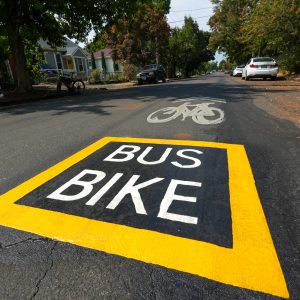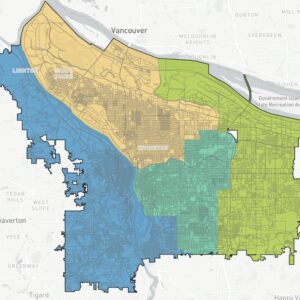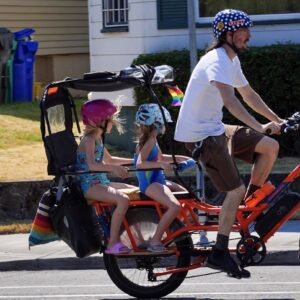[Update: more photos of the markings]
In the past 24 hours I have heard from several reliable sources that the new Hawthorne Bridge markings were done with little to no input from cyclists. One bike advocacy insider went so far as to say:
“I am incredibly disappointed in the County (again, I might add) for failing to include an engineer in the Bridge Advisory Committee. Once again, bikes get screwed.”
The county also ignored a letter of concern written by the Portland Bicycle Advisory Committee (PBAC) and didn’t even warn them about the new markings. This bridge is a major artery of the bike network and is unacceptable for the County to make major “improvements” without heeding input and feedback from the PBAC and the bike community.
If you have a few minutes, here is the contact information for all the key players responsible for the new markings. Please consider letting them know what you think (Note: Before contacting anyone, please take a minute to read the comments to this post):
Planner for Multnomah County: Matthew Larson
matthew.f.larsen@co.multnomah.or.us
ph: (503) 988-5050 ext. 29637.
———————————————-
County chair: Diane Linn
Phone: (503) 988-3308, fax (503) 988-3093
E-mail: mult.chair@co.multnomah.or.us
———————————————————————-
Commissioner Maria Rojo de Steffey
Phone: (503) 988-5220 / fax (503) 988-5440
E-mail: district1@co.multnomah.or.us
————————————————————————————————-
in charge of Transportation for the county Commissioner:
Lonnie J. Roberts
Phone: (503) 988-5213 / Fax: (503) 988-5262
lonnie.j.roberts@co.multnomah.or.us
Did you ride over the Hawthorne Bridge this morning? If so, I’d love to know what you think of the new markings.
(Also see the comments from my previous post for more opinions.)







Thanks for reading.
BikePortland has served this community with independent community journalism since 2005. We rely on subscriptions from readers like you to survive. Your financial support is vital in keeping this valuable resource alive and well.
Please subscribe today to strengthen and expand our work.
I thought the new markings were a good idea, and I’m really glad they took out those aweful bump marks, but they really have bikes riding right on the edge of the walkway in an incredibly narrow strip of pavement. It seems like that poses the greatest risk, for cyclists and for drivers: having us ride in such a narrow strip and so close to the edge of the drop-off means that there’s great potential for a biker to fall into the traffic lanes if they experience a problem while riding.
I rode over the Hawthorne bridge this morning and actually thought that the new lanes were a good idea and worked well. The lane IS narrow, but it isn’t very long, It just runs for 50 feet or so in an effort to bikes away from the folks that are merging in from the ramp that comes up from the river trail. To me it was no big deal at all.
I rode and observed the new striping on the westbound sidewalk of the Hawthorne both yesterday afternoon (at about 2 pm) and again this morning (8:30 am). I observed about 90-95% compliance with the markings. Cyclists seemed to intuitively understand where they were supposed to ride and didn’t seem to have any problems staying within the lines.
I’m not sure there is really a great potential for a biker to fall into the traffic lanes. I like to think that people riding bicycles have enough common sense and skill to be able to prevent themselves from falling off a curb through either a combination of riding slower or, if a problem develops, to veer away from the roadway.
Prior to its reconstruction in 1998-99 cyclists shared a 6-foot wide sidewalk on the Hawthorne with pedestrians (the path is now 10-feet wide). Under those conditions, pedestrians walked in single file against the railing and cyclists rode in single file close to the curb. It was tight. It’s possible that during the many years those conditions existed a cyclist may have fallen into the roadway, but, if it did happen–and I can’t recall specifically that it ever did–it was certainly rare.
Before drawing conclusions about how the new markings are working, I recommend riding the path and observe how you and other cyclists respond to the markings.
The process was not the greatest, but consider divorcing concerns about the process from an honest evaluation of how the markings are working.
Having read all the comments on this blog, the Shift list, and listened to a fair amount of discussion in the bike-o-sphere, the main conclusion I hear is: process bad, product good.
While I’m no fan of bad process, I’d advocate for going slow on hounding the elected so as not to dilute our impact when we have to deal with a genuinely bad product.
I join Severt in his feeling that slowing down cyclists in this constricted, mixed-use area is a good thing. You know my motto – TFFC? STFD! (Too Fast for Conditions? Slow the _ Down!)
Roger, I appreciate your input and I plan to check out the markings first hand later this afternoon. I’m also glad to hear that you find the markings to be an improvement. Judging from the responses so far, I think the majority of cyclists like the new markings.
My concerns came from the fact that the County didn’t listen to cyclists before acting …but if the markings work and most cyclists like them, then I guess we got lucky on this one.
It’s just that whenever I hear of someone ignoring the PBAC and not being open about such important bike infrastructure plans I get concerned. Again, thanks for your insights.
______________
Timo,
I agree with you about crying wolf on this one. The more I’ve heard from folks, the more I feel like perhaps I should go back and “call of the dogs”. Then again, I doubt anyone will contact these officials if the passion isn’t there to begin with…but either way, I hear what you’re saying.
Let’s talk some about the installation process itself. This morning the county crew was out working on this again. On the viaduct approach, they had put their “right lane closed ahead” signs squarely in the bike lane, interfering with oncoming cyclists. They again had the sidewalk blocked to bicyclists, there were no detour signs, and bicyclists were forced to merge left and share the center bridge lane with motor vehicle traffic. All fairly unacceptable in my opinion.
“My concerns came from the fact that the County didn’t listen to cyclists before acting …but if the markings work and most cyclists like them, then I guess we got lucky on this one.”
— Like I said yesterday (and afterwards went over the bridge just to check it out), I think these markings have the potential to make the bridge safer. I’m still not going to use the Haw bridge much, since the main problem imho was one I’m happy about in the end: Portland is working on becoming the first US city with major bicycle traffic jams during rush hour on that bridge. Good for us, now we just need that outside car lane going both ways paved over. Until then, I’ll cut over to Burnside.
As for the process, Jonathan is on the money. I shot a quick email to Maria Rojo de Steffey with a crap sandwich first thanking the city for the bicycle infrastructure and general improvements, and then asking that there be more transparency and input from the bike community when changes like this occur, since as users of these facilities, we are their best resource to get it right the first time.
I think e-mails worded like this aren’t “calling in the dogs” and will let them know that there are many willing and energetic bicyclists in the city who’s knowledge can be tapped for things like this.
Jonathan, I share your concern. The Hawthorne is the preeminent bikeway in Oregon by virtue of cyclist volumes and the importance of its connection. I am concerned about such significant changes made without a broader technical review. If the changes were not working well I wonder how quickly the striping could have been removed. I don’t think that operational changes on major infrastructure serving other modes of travel, similar in scope to what’s been done on the Hawthorne for the bicycle/pedestrian environment, would have been enacted with such sparse review.
I think this is a reflection of bicycling still not being taken seriously enough as a legitimate mode of travel.
Here’s the e-mail I received from Matt Larson after I emailed everyone on your list. He claims in the letter that the BTA was involved in this decision via a committee held this summer. If someone from the BTA is around, it’d be nice to get an update from them re: how that process went.
—————
Thank you for your comments. The plan for the new markings installed on
the Hawthorne Bridge sidewalk were developed by a committee of bridge
users that met over a three month period this summer. The committee
members represented the Bicycle Transportation Alliance, the Portland
Bicycle Advisory Committee, the Multnomah County Bicycle and Pedestrian
Citizens Advisory Committee, the Portland Pedestrian Advisory
Committee,
the Willamette Pedestrian Coalition and Elders in Action. The committee
unanimously recommended the markings that the County installed. I hope
that the new markings improve the experience on the Hawthorne Bridge
for
pedestrians and bicyclists.
Matthew Larsen
Transportation Planning Specialist
Multnomah County
503-988-5050 ext. 29640
I would appreciate hearing from Roger and other BAC members, as I thought the BAC *was* represented on the small committee that looked at this issue through the BAC members took part in it. I also remember that the BAC was going to be given the chance to review the plan and comment. Did that not happen?
I was the BTA representative on this committee, and I felt like it was generally a very positive thing that the County was willing to consider innovative solutions and the not drag their feet on installing them.
I also know that I asked all BTA staff to weigh in on the proposal, and I had assumed that the full BAC would also get to review and comment on it as well. If that was not the case, I see that as a problem. Also, I’d like to hear from Roger what kind of a technical review he has in mind, and if that’s different from the technical input the BAC can provide.
To put this in perspective: cyclists in most other cities are begging to get innovative pavement markings and are getting the bureaucratic smackdown. Many cities would have just put up dozens of anti-bike signs, made more and bigger bike speed bumps, and increased enforcement actions against bicyclists.
I really felt like this solution was a step in the right direction in terms of creating an intuitive, clear environment that helps peds and bikes co-exist even though we have the fortunate problem of (almost) too many users in a small space. We also agreed that the treatment must be evaluated with before and after observations. I hope and assume the County will do that.
Jessica, it sounds like you (the BTA) are fine with the process and the solution (as far as your involvement)?
Roger said: “I think this is a reflection of bicycling still not being taken seriously enough as a legitimate mode of travel.”
Then how does the City think Portland is ready for Platinum status?
My two cents: I cross the bridge sometimes 4 times a day, and I greatly appreciate the new stripe/markings. I see it as mostly protecting pedestrians from getting mowed over by cyclists slingshotting around the bend. The markings simply reinforce an already existant unsaid code of pedestrians by the railing and bikes by the road.
I agree with Randy’s post, the implementation and detour was very bad; I too was forced to ride in the very center of the bridge this morning, which was unnecessary and inconvenient.
Forget Platinum, lets go ‘diamond’ and make constant steady progress in getting as much bicycle infrastructure as possible in Portland. Thanks to Jessica and others for the great work.
Johnathan,
I think the bridge markings are great. Yes, the bike portion is very narrow, but I think it is much safer than before.
It is really hard to see pedestrians coming around that blind corner, and the marking help keep both parties safe even if they can’t see each other. I’m not much interested in the politics of it all, but certainly think it is an improvement.
Someone mentioned the Burnside Bridge in these exchanges. Let’s all get behind making it two motor vehicle lanes in both directions and widening the bike/ped portion. Why three auto lanes in one direction and two in the other when Burnside is basically a 4 lane arterial? A wider sidewalk/bikeway could really make the bridge a wonderful promenade.
In the late 16th century, Henry IV of France, built the Pont Neuff with just such a promenade featuring a statue of himself in the center (maybe there’s a spot for Portlandia on the Burnside Bridge?). Anyway, it marked the beginning in Paris of a shift from “the river as sewer” to the “river as open space.” I think Portland might be ready to make such a move.
bridge markings are a great idea and if a rider feels unsure about safety issues related to any situation it is quite simple to simply SLOW Down! I’ve had several closecalls from other riders passing a high speed with no warnings both on bridges and on the esplanade. I suppose those who “blast along” pprobably don’t read these blogs anyway!
I think we’re all lucky they didn’t go with my proposal for modifying bicyclist and pedestrian behavior:
http://flickr.com/photos/nacho/37218365/
If cyclists wish to get involved and give input into county bicycle related decisions all they have to do is attend the county bicycle advisory committee meetings. They are open to the public. They meet every 2nd Wednesday of the month at the county building – same place you get marriage licenses – 501 SE Hawthorne Blvd – from 7 PM to 9 PM. The agenda always has a spot for public comment.
In response to Jessica Roberts:
Yes, the BAC was represented on the Bridge Advisory Committee. However the composition of that committee was decidedly non-technical, in the sense that it did not include enough people who have studied and implemented designs for bikeways. It was essentially a Citizen’s Advisory Committee, which is a great thing, but which should not be seen as an endpoint for technical review.
Portland has a lot of bicycle facilities, both on- and off-street. With the building of those facilities we’ve acquired a lot of experience. At a minimum I would have liked to have seen County staff consult with Portland’s path builders (primarily our Parks Bureau) to hear about the range of options they’ve considered over the years to provide some level of separation between cyclists and pedestrians and why they’ve rejected or adopted them.
I’m glad the bridge markings seem to be working. My point was that given the importance of the facility to the bicycle network it could have easily benefitted from one more level of review before implementation.